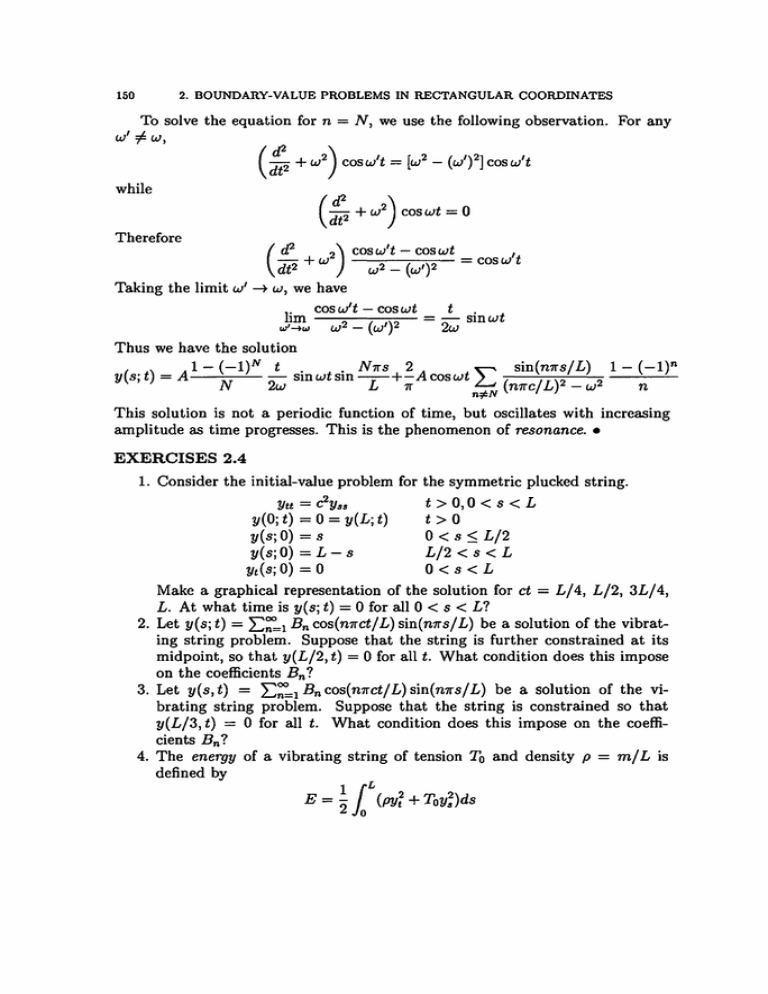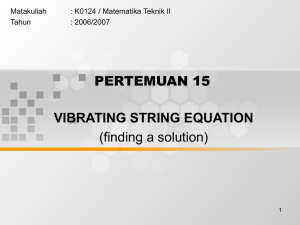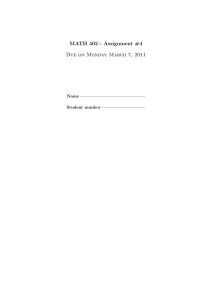2) COS wit
advertisement

150
2. BOUNDARY-VALUE PROBLEMS IN RECTANGULAR COORDINATES
To solve the equation for n = N, we use the following observation. For any
Wi =1= W,
(;; + w.) cosw't = [w' - (w')'] cosw't
while
(:. + w' )
Therefore
Taking the limit Wi
cos wt = 0
f12
2) COS wit - cos wt
w2 _ (W/)2
( dt 2 + W
~ w, we have
I
= cosw t
. cos wit - coswt
t .
11m
=
smwt
2
w'-+w
w - (W')2
2w
Thus we have the solution
1 - (-l)N t .
. N1rs 2
' " sin (n1rs/ L) 1 - (-l)n
y(Sjt) = A
N
-2 smwtsm- +-Acoswt L..J (
/L)2
2
L
W
7r
n:l;N n7rC
- w
n
This solution is not a periodic function of time, but oscillates with increasing
amplitude as time progresses. This is the phenomenon of resonance.•
EXERCISES 2.4
1. Consider the initial-value problem for the symmetric plucked string.
Ytt =
y(O; t)
2
C YS8
= 0 = y(L; t)
y(s; 0) = s
y(s; 0) = L -
S
t > 0, 0 < S < L
t>0
0 < s 5: L/2
L/2 < S < L
0<s<L
Make a graphical representation of the solution for ct = L/4, L/2, 3L/4,
L. At what time is y(s; t) = 0 for all 0 < S < L?
2. Let y(s; t) = 2:~1 Bn cos (n1rct/ L) sin(n1rs/ L) be a solution of the vibrating string problem. Suppose that the string is further constrained at its
midpoint, so that y(L/2, t) = 0 for all t. What condition does this impose
on the coefficients Bn?
3. Let y(s, t) = 2::=1 Bn cos (n7rct/ L) sin(n1rs/ L) be a solution of the vibrating string problem. Suppose that the string is constrained so that
y(L/3, t) = 0 for all t. What condition does this impose on the coefficients Bn?
4. The energy of a vibrating string of tension To and density p = m/ L is
defined by
L
1
2
2
E = 2"
(pyt + Toys)ds
Yt(s; 0) = 0
Jor
2.4. THE VIBRATING STRING
151
Let
00
- coswnt + En
- sinwnt) sin L
nn8
Y(8; t) = ""
~(An
n=l
be a solution of the wave equation with Wn = nnc/ L. Use Parseval's
theorem to write E as an infinite series involving An, En and verify the
law of conservation of energy.
5. Let y(s; t) be a solution of the wave equation Ytt = c?Yss satisfying the
boundary conditions y(O; t) = 0 = y(L; t). By differentiating under the
integral sign, show directly that dE / dt = 0, where E is the energy defined
in Exercise 4.
6. Consider the initial-value problem for the plucked string of Example 2.4.2.
Compute the total energy corresponding to normal modes n ;f= 1 and show
that this is less than half of the total energy.
7. Suppose that 12(8), -00 < s < 00, is an odd, 2L-periodic function. Define
y(s; t) = (1/2c) fs8~~t 12(z) dz; show that y(O; t) = 0, y(Lj t) = 0 for all t.
8. Let I(s), -L < 8 < L, be a piecewise smooth function. Extend 1 to a
2L-periodic function defined for -00 < S < 00. Show that the resulting
function is piecewise smooth on every interval a < s < b.
9. Let 1(8), -L :::; s :::; L, be an odd function. Extend 1 to a 2L-periodic
function defined for -00 < 8 < 00. Show that the resulting function is
again odd.
10. Let 1(8), -00 < 8 < 00, be an odd function with the property that I(L8) = 1(8). Show that 1(8 + L/2) + 1(8 - L/2) = 0 for all 8.
11. Let I(s), 0 :::; 8 < L, satisfy 1(8) = I(L - s). Let y be the solution
(2.4.12) satisfying y(s; 0) = 1(8), Yt(S; 0) = O. Show that y(8, L/2e) = 0
for 0 < 8 < L.
12. Show that the Fourier series solution obtained in Example 2.4.2 converges
uniformly for 0 ~ s :::; L.
13. Consider the following initial-value problem for the wave equation Ytt =
c?Y88 for t > 0, 0 < s < L: y(Oj t) = y(Lj t) = 0 for t > 0; Y(8j 0) = 0 and
Yt(8j 0) = 1 for 0 < 8 < L.
(a) Find the Fourier representation of the solution.
(b) Find the explicit representation of the solution and graph the solution for t = 0, L/4e, L/2e, 3L/4e, L/e.
Exercises 14 to 16 are designed to review the techniques from calculus that
are used in establishing d'Alembert's formula. Recall that the fundamental
theorem of calculus states that (d/dx) I(z)dz = I(x) for any continuous
function I. The chain rule for differentiating composite functions states that
(d/dx)F(G(x» = F'(G(X»G'(x).
14. Let 1 be a continuous function and set F(x) = foX J(z) dz. Show that
f:~~t J(z) dz = F(x + et) - F(x - et).
f;
152
2. BOUNDARY-VALUE PROBLEMS IN RECTANGULAR COORDINATES
15. Use the chain rule and the fundamental theorem of calculus to show that
(d/dx) f:~~t J(z) dz = J(x + ct) - J(x - ct).
16. Use the chain rule and the fundamental theorem of calculus to show that
(d/dt) f:~~t J(z) dz = cJ(x + ct) + cJ(x - ct).
17. The voltage u(x; t) in a transmission cable is known to satisfy the partial
differential equation Utt + 2aut + a2 u = c2uxx , where a and c are positive constants. Let y(x; t) = eatu(x; t) and show that y satisfies the wave
equation Ytt = c'lyxx'
18. Use Exercise 17 and d'Alembert's formula to solve the initial-value problem
utt+2aUt+a2u = r?u xx for t > 0, -00 < x < 00, with the initial conditions
u(x;O) = gl(X), Ut(x;O) = O.
19. Use Exercise 17 and d' Alembert's formula to solve the initial-value problem
2
Utt + 2aut + a u = r?uxx for t > 0, -00 < x < 00, with the initial condtions
u(x; 0) = 0, Ut(x; 0) = g2(X).
20. A vibrating string with friction in a periodic force field is described by the
equation Ytt + 2aYt - c2 yss = Acoswt and boundary conditions y(O; t) =
= y(L; t), where A, a, and ware positive constants. Find a particular
solution that is also periodic in time.
°
2.5. Applications of Multiple Fourier Series
In this section we consider boundary-value problems in rectangular coordinates
(x, y, z) where more than one of these variables appears in the solution. This is
in contrast to the previous sections, where the solution depended on z alone. We
will solve initial-value problems for the heat equation, boundary-value problems
for Laplace's equation, and the wave equation for a vibrating membrane.
The key idea in our work is a double Fourier series. To illustrate this, we
display a double Fourier sine series,
00
'" A
. m1rX . n1rY
L...J mnslllL slllL
m ,n=1
1
2
which may be used in problems involving a rectangle or column, described by
the inequalities 0 < x < L 1 , 0 < Y < L 2 • Similarly, a double Fourier cosine
series is of the form 2: Amn cos (m1rx/ L 1 ) cos{n1rY/ L2). Clearly we could consider
other combinations of these, where we mix sines and cosines, for example. All
double series of this type are of the form L:m.n l/Jm{x)'l/ln(Y), where l/Jm, 'l/ln are
the eigenfunctions of a Sturm-Liouville eigenvalue problem. Accordingly, the
corresponding functions of two variables obey suitable orthogonality relations.





